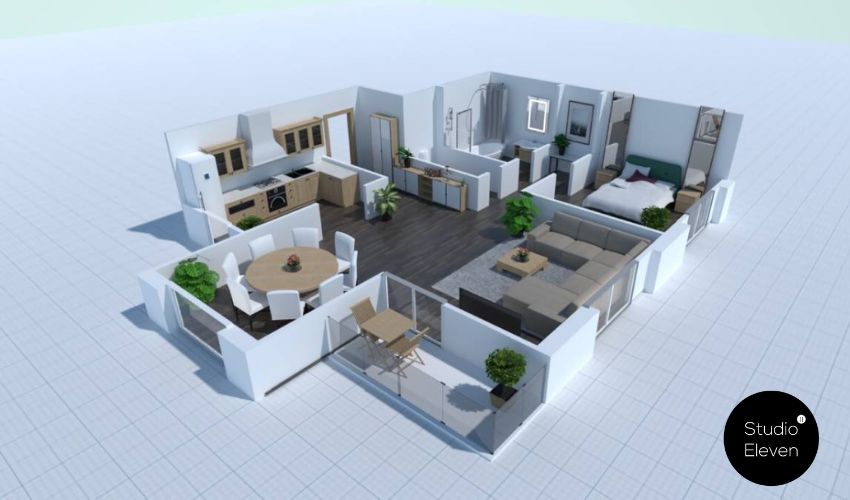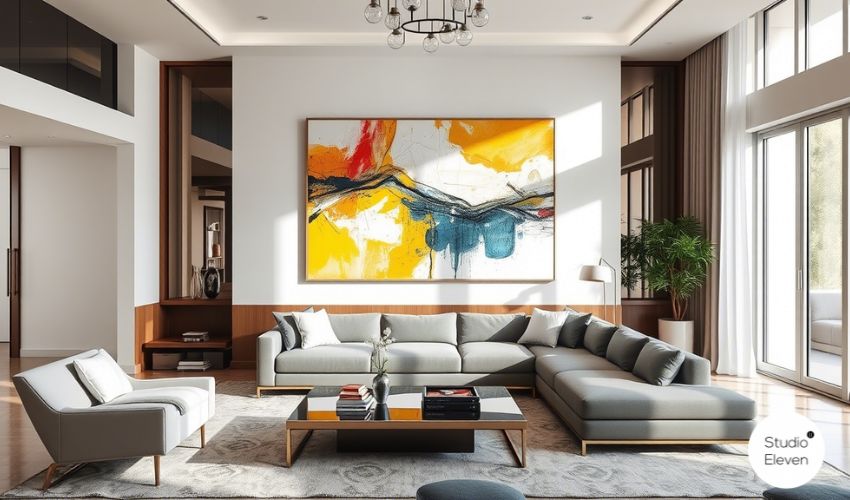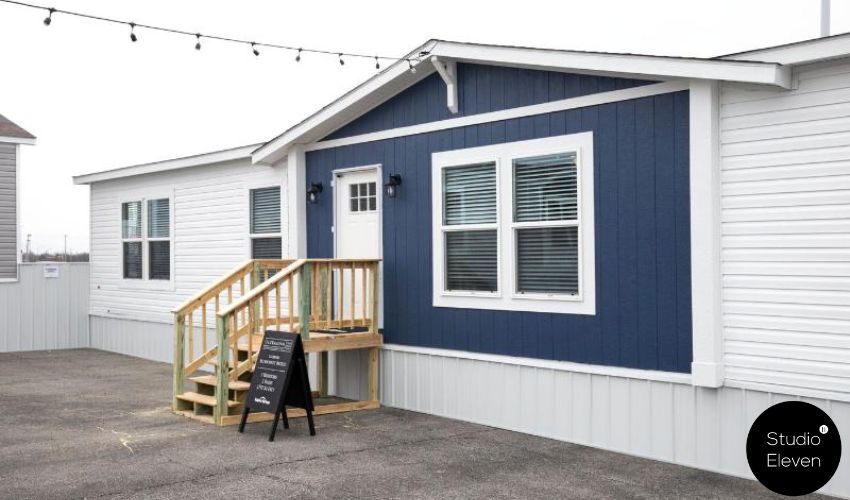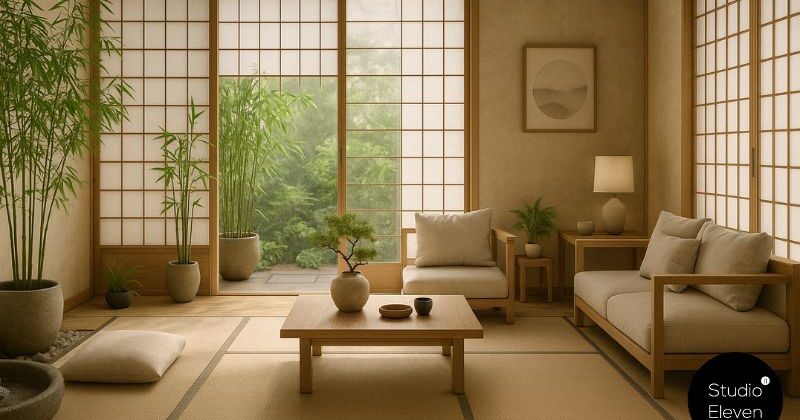
Origins of Zen Interior Design
The Zen style originates from Japanese Buddhist architecture. It is named after the Zen sect of Buddhism. Zen itself derives from Chinese Song Dynasty architecture. Zen Buddhism arrived in Japan around the 12th century.
Zen philosophy emphasizes meditation, mindfulness, and living in harmony with nature. These principles directly influence the design style. Simple lines, Natural materials, and a minimalist aesthetic characterize Zen interiors.
Japanese design incorporates Zen through concepts like wabi-sabi, the beauty of imperfection. Shibui, meaning simple and subtle beauty, is another related Japanese concept.
Important Principles of Zen Interior Design
- Minimalism and Simplicity
- Connection to Nature
- Balance and Harmony
Minimalism and Simplicity
Minimalism sits at the heart of Zen interior design. A cluttered space often contributes to a cluttered mind. Achieving a Zen-inspired home starts with reducing belongings. Focus on keeping only essential items or things bringing joy.
Regular decluttering is very important. Use storage solutions effectively to keep surfaces clear. Choose furniture with clean lines and practical function. Natural materials like bamboo or wood are ideal for furniture.
Embrace open space within rooms. Negative space allows energy to flow freely, creating openness. Simplicity means avoiding overly decorative or complex designs. Keep the design straightforward yet stylish.
Connection to Nature
Bringing nature indoors is fundamental to Zen design. Nature creates a sense of grounding and tranquility. Stone, bamboo, and wood are natural materials that you must use extensively. Wood is often preferred for floors and furniture. Incorporate indoor plants like bamboo, bonsai trees, or peace lilies.
Greenery purifies the air and enhances the visual appeal. Ensure plants are leafy green rather than brightly colored. Consider adding a small indoor fountain. The sound of water promotes calmness. Pebbles can also serve as natural decorative elements.
Also Read: How to Design an Eco Friendly House
Balance and Harmony
Achieving the right balance is critical in Zen interior design. Creating balance requires conscious effort to inspire inner peace. Arrange furniture symmetrically or in a visually balanced way. Ensure there is plenty of space for easy movement.
The furniture layout should encourage flow and openness. Feng Shui principles often influence Zen layouts to promote positive energy. Harmony is reflected through the minimalist approach. Consistent use of colors and materials maintains harmony. Create a focal point in each room, like a low table. Every element should contribute to an overall sense of peace.
Essential Elements of Zen Style
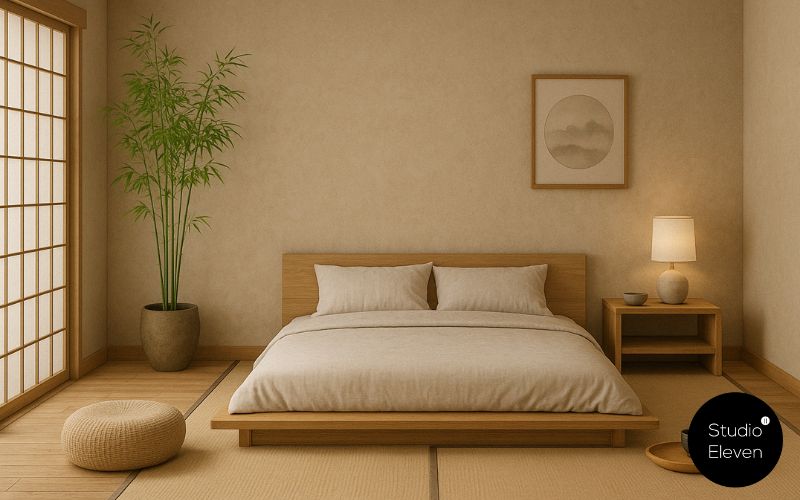
Essential elements of Zen interior design or style are:
- Neutral and Natural Color Palette
- Soft and Natural Lighting
- Furniture Selection
- Textures and Materials
- Mindful Décor
- Sound and Scent
Neutral and Natural Color Palette
Zen interiors use calming, neutral tones reflecting nature. Common colors include beige, taupe, soft grays, and white. Earthy tones create a soothing atmosphere conducive to relaxation. Use muted greens, blues, or browns sparingly as accent colors. Accent colors add depth and reinforce the connection to the outdoors. Moreover, soft, pale shades convey calm and tranquility. Avoid harsh or dark colors.
Soft and Natural Lighting
Zen Mood depends on the lighting. However, sheer curtains should be used to allow sunlight while maintaining privacy. Sheer drapes diffuse light, creating a soft effect. Aim for smooth, natural light sources instead of harsh, bright ones.
Layer ambient, task, and accent lighting for warmth. Choose bulbs with a soft, warm glow. At night, lighting should be subdued using lamps, sconces, or indirect lighting. Japanese-style paper lanterns offer soft, atmospheric light.
Furniture Selection
Zen furniture features clean lines and simple forms. Pieces are functional and often low profile. Natural materials like wood and bamboo are common choices. Avoid elaborate ornamentation or excessive detail. Furniture arrangements should feel balanced and allow free movement. Consider multi-purpose furniture to maintain simplicity. Low tables and floor cushions can enhance the Zen atmosphere.
Textures and Materials
While minimalist, Zen interior design uses texture for warmth. Incorporate natural materials like linen, cotton, wool, or jute. Use these textures in rugs, cushions, and throws. If using patterns, choose subtle, nature-inspired designs. Layer different textures to make the space feel cozy yet understated. Natural fabrics bring a subtle sophistication. Wood floors are preferred for their natural feel. Textured, imperfect surfaces align with the wabi-sabi aesthetic.
Mindful Décor
Every item in a Zen space should serve a purpose or bring joy. Avoid overcrowding rooms with unnecessary decorations. Choose simple, meaningful decor pieces like a single painting. Incorporate items evoking peace, such as a Buddha statue or meditation cushion.
Display items like family photos or meaningful souvenirs thoughtfully. Natural elements themselves act as decor, like plants or pebbles. Consider a mini Zen garden for relaxation and mindfulness practice.
Sound and Scent
Sound contributes significantly to a Zen atmosphere. Play calming music, nature sounds, or white noise. Use rugs, curtains, and cushions to absorb excess noise. Embrace silence sometimes for mental clarity. Incorporate soothing scents through candles, essential oils, or incense. Lavender, sandalwood, or eucalyptus scents are good choices. Avoid strong, overpowering fragrances.
Applying Zen Interior Design in Your Home

Zen interior design principles adapt well to various rooms. A living room might feature a low sofa, neutral cushions, and a bonsai tree. Shoji screens can act as room dividers. A Zen bedroom often includes a simple platform bed and soft lighting.
Tatami mats are a traditional flooring option. Zen home offices promote focus with simple desks and natural light. Spa-inspired bathrooms benefit greatly from Zen elements like natural stone and plants. Kitchens can also adopt Zen style through clean lines and natural materials. Always hire a professional interior design company with expertise in Zen design to get the job done adequately.
Benefits of Choosing Zen Design
- Promotes mental and physical well-being.
- Creates a relaxing environment focused on tranquility and balance.
- Encourages mindfulness through simple, uncluttered surroundings.
- Possesses a timeless and enduring aesthetic appeal.
- Supports a lifestyle choice that prioritizes harmony.
- Fosters an overall sense of peace and serenity.
- Helps reduce stress by creating a calmer, less busy setting.
- Develops and strengthens a connection to the natural world.
Common Misconceptions of Zen Interior Design
- Zen style is not cold; it achieves warmth and coziness through minimalism.
- Natural materials and soft colors prevent Zen spaces from feeling uninviting.
- Zen interiors allow personal expression via mindfully selected meaningful items.
- Zen principles offer guidance, not rigid rules that stifle creativity.
- Creativity is encouraged within the flexible framework of Zen design.


